Do you know how to run?
It’s a simple question, and probably something you might not even think about. After all, what’s so tough about running, right? You put one foot in front of the other, repeat the process as quickly as possible, and BAM you’re running!
However, did you realize that running improperly, especially for long distances, can do some serious damage to your body while not even giving you the benefits you’d expect from putting in all of that effort? Not cool, I know.
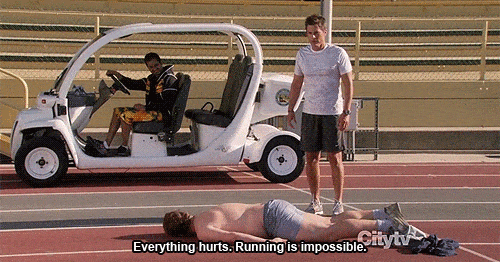
Luckily, Nerd Fitness is here to help!
Today, you’re actually going to learn how to run the right way, keeping you healthy, happy, and injury-free.
Before we jump in, it’s no secret that I’m a huge fan of strength training. If you were going to start just one single exercise program, instead of running, I would recommend lifting heavy.
If you’re interested in learning why, and how to get started, check out our guide Strength Training 101: Everything You Need to Know. You can grab it for free when you join the Rebellion below:
- Everything you need to know about getting strong.
- Workout routines for bodyweight AND weight training.
- How to find the right gym and train properly in one.
Do you want to run?

First and foremost, when people tell me they’re going to start running, I always ask: “do you enjoy running?”
If the answer is “no,” then I yell at them (nicely), “THEN DON’T DO IT!”
If you are starting to run because you want to lose weight, but don’t actually enjoy running, I HAVE GREAT NEWS! You don’t have to run; in fact, there are more efficient ways to burn the right kind of calories. Your diet will be 80% of your battle anyways, so if you can find a way to start eating healthy, your exercise can come from activities you DO enjoy – hiking, strength training, martial arts, Ultimate Frisbee, whatever.
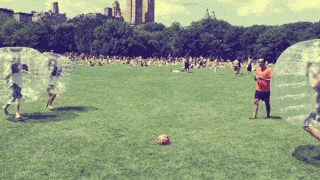
Now, if you answer with something like:
- “Yes! I love running,”
- “I like interval training and sprints”
- “I don’t love it, but I need to complete it for a fitness test”
- “I’m running a 5k for charity/work and want to do well”
- “Not yet, but I think I could…”
…then we can continue the conversation! Let’s take a look at the first few important steps (get it!) when it comes to running.
What to do first
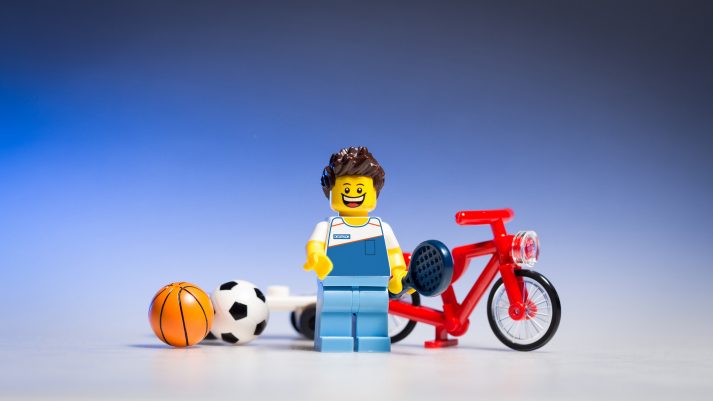
Before you even THINK about strapping on a new pair of Nike shoes and going for a run around your neighborhood, we need to get a few things straight:
Your body needs to have a base-level of fitness before running becomes a viable option. Every time you run, every time you take a step, you put the pressure of your entire body weight on the muscles, tendons, and joints in your legs, knees, ankles, feet, and toes. If you are overweight and have improper running technique, that means your joints and tendons are taking an absolute POUNDING for however many steps you take during your run: around 6,200 steps in a 5k, 12,200 steps in a 10k, or 50,000+ steps in a marathon.
You’d have to be crazy to want to do something that hurts your body 50,000 times in a row!
So, clean up that diet, strength train every other day with something like our Beginner Bodyweight Workout, and then do some form of low-impact activity on your off-days. Things like:
- Hiking – my personal favorite: get out and see the world!
- Biking – easy on your joints, gets you moving.
- Swimming – very low impact as the water holds you up.
- Walking – go for a nice long walk around your town, and keep your head up. Enjoy the scenery.
- Elliptical – although I’m not a fan of spending all afternoon in a gym on a treadmill, this is the better option as it removes the opportunity for joint impact.
Strength training, clean eating, and low impact activity – build up at your foundation to prep your body for running. The less weight your body has to carry around, the less work your legs and joints have to do, the less likely you’ll be to damage your joints and/or injure yourself.
Now that you have a solid foundation and you’re ready to start running, you can move on to the next step.
Does any of this stress you out? We get tons of emails from Rebels, panicked that they don’t know where to start their fitness journey.
Should they start walking first? What about focusing all their effort on nutrition? Keto seems popular, is it something they should try?
These types of inquiries are exactly why we created our 1-on-1 Online Coaching Program. We sought to take all the guesswork out of getting in shape, by creating a program designed to tell you exactly what to do.
Here’s how it works: we get to learn your goals, lifestyle, challenges, and situation: Kids? An old injury? A job that requires travel? All the above? We got you covered.
We’ll then pair you with a coach from Team Nerd Fitness that fits your personality and situation. They’ll work with you to build custom workouts and nutrition guidance to meet any goal you might have. Unless that goal is ruthless world domination. Use your powers for good, okay?
Want to see if we are a good fit for each other? Click on the button below to schedule a free call. We’d love to talk to you, no matter what!
How to warm up properly

Before you take your first stride as a runner, you need to be properly warmed up.
When most people think of warming up, they probably think of standing there and doing some static stretching for 10 minutes…you know, to make sure you don’t get injured!
Wrong! Fail! Stretching BEFORE running can actually increase your risk of injury.[1] Instead, try a dynamic warm-up – get your body properly warmed up and prepared for the rigors of running.
Here’s Staci, our head female coach, providing you with a quick sequence to try out:
You can also check out our post “How to Warm Up Properly” for more moves and tips.
Just like with strength training, if you don’t have time to warm up, you don’t have time to run. Cut the run short if you need to, but not the warm up!
How to run properly

If you don’t learn how to run correctly, you’re doomed to develop an overuse injury and that’s going to negate the whole reason you started running in the first place!
This is why your running form is so damn crucial: when you run, you’re putting hundreds of pounds of pressure on your joints and ligaments with each bounding step down the road. This is then repeated thousands of times over the course of training and a race.
No wonder nearly every runner has tons of stories of injuries they’ve had to deal with. It can be a brutal activity that can wreak havoc even with good running mechanics.
With poor running mechanics, the results are compounded.
And not the GOOD kind of “compounded” like compound interest like you learned in 2nd grade with the story about starting with 1 penny a day and doubling it for 30 days.
The BAD kind of “compounded” like plantar fasciitis and stress fractures and sore IT bands and torn ligaments and crazy soreness all the time.
We don’t want that.
Make sure you follow the below five steps:
1) Lean from your ankles. Lean from your ankles, and keep a straight line from your ankle, through your butt, and up to your head. If you’re standing still with this slight forward lean, you should feel like you’re about to fall forward.
Just don’t actually fall forward.

When you start running, gravity will help keep you progressing forward. A proper lean from the ankles keeps your body in alignment and loads your muscles properly and efficiently.
2) Increase your cadence. Cadence is your stride rate, or the number of steps you take per minute. It will probably seem weird at first, but you’re putting less stress on your legs with shorter foot strikes.
Your cadence should be at least 170-190 steps per minute when you’re running at an easy, conversational pace. It will probably increase once you start running faster—that’s normal.
“Steve, what the hell do I do with “170-190 steps per minute?”
Great question. Go to Spotify and look for 170-190BPM playlists, like these which I found here:
Not on Spotify? Cool. (But like, why?) To get a cadence, try running to Outkast’s “Hey Ya” and time your strides to match the beat. That’s the cadence you’re looking for:
Research has shown[2] that increasing your cadence and taking more steps (around 180 per minute) provides many of the same benefits of barefoot running: less impact shock that goes up your legs, improved running economy (or your efficiency, which means you’ll run faster with less effort!), and a reduced chance of injury.
You’ll feel like you’re taking way more steps than normal – that means you probably had poor form before and now you’re fixing it!
If your legs get to the point where they’re going this fast, let me know:

3) Foot strike at the right time. When your foot comes down and makes contact with the ground, it should be underneath your body, not in front of it. Combined with a quick cadence and a slight forward lean from your ankles, you’ll be distributing impact shock evenly—and efficiently.
This aspect of running form is often skipped over by beginning runners. Instead of focusing on where the foot is landing in relation to the rest of the body, they focus too much on running on their forefoot. If you don’t first land in the right place, a midfoot or forefoot strike will only do more damage.
As you’re running, a good mental cue is to think that you’re just “putting your foot down” in a straight line underneath your body. There’s no reaching or stretching your leg out in front of you. Practicing this mental cue will have your leg touching down almost exactly underneath your center of mass, distributing your weight evenly and safely.
4) Land on your mid-foot. While not as important as landing underneath your center of mass, becoming a mid-foot striker has a host of benefits. It can help you avoid a lot of injuries by absorbing impact shock and preventing a severe heel striking running stride.
Heel-striking can’t be entirely blamed for injuries and labeled “bad.”
Even elite athletes heel strike when they run races! It’s not entirely bad— especially if you’re putting weight down on your foot just after you heel strike, instead of directly on the heel.[3]
What you should focus on is having a higher cadence, landing underneath your body, and not aggressively heel striking. Try to land with your foot flat on the ground, instead of with your toes angled upwards.[4]
5) Symmetrical arm swing. Nobody wants to look at you running if you’re flailing your arms wildly all over the place like Elaine dancing from Seinfeld. An ideal arm swing has your arm bent at about 90 degrees and a front to back swing (not side-to-side).
Imagine a pretend line that goes down your mid-line or center of your body. When you run, your hands should not cross over this imaginary line. Cup your hands loosely together (no clenched fists!) and if you want to use your arms for momentum, pump your elbows, not your hands.
Once you incorporate these changes into your running form, you’ll feel a lot more comfortable and your injury risk is going to plummet.
For extra credit, learn to run softly and quietly. Foot stomping isn’t allowed and gets increasingly more difficult as you approach 180 steps per minute.
A few other things you want to keep in mind:
- Keep a tall back, chest up. No slouching.
- Look 30-50 meters in front of you – not head down looking at your toes.
Both are easy cues to keep an athletic posture and good running form.
Go back through and read this section a few more times. We know it’s a LOT to think about while running, but it is incredibly important. If you get a chance, have somebody film you running, and then watch your tape back to see how you’re doing.
WALK BEFORE YOU RUN

Starting a running practice can be daunting.
That’s why I actually recommend walking first. I mentioned earlier that walking can help build the foundation of a great running practice.
Once you’re comfortable moving a little bit, an ideal way to actually start running is to alternate between a brisk walk and a jog. This can help you build up some strength so you can run at a more constant pace.
Try this:
- Get comfortable walking for 20 minutes. That’s it. Stroll around your neighborhood a few times a week, until this is a cake walk.[5]
- Bump it up to 30 minutes. After 20 minutes is no problem, take it to the next level for a 30-minute walk. Once you can handle this fine, we can start picking up the pace.
- It’s time to start run/walking. Walk as you have been for 10 minutes. Then, pick up the pace for a light jog for a minute (or 30 seconds if this is too tough). Give yourself a couple more minutes of walking (or longer) before you start jogging again. Do this for about 10 minutes, then walk normally for the last 10 minutes. You’ll still come in at 30 minutes for your exercise.
- Now, run for longer. Once your comfortable holding a one minute jog, let’s take it up a notch. We’ll still have you warm up for 10 minutes of walking, but when you jog, try going for a minute and a half. If this seems easy, go for 2 minutes! Alternate to a slower walk whenever you need to catch your breath.
- Before you know it, you will be a runner. As you expand your jogging time, lower the amount of time you walk. At this point, you’re basically running with some short walking breaks. Which is fine! This is how people start to run and many continue to alternate between walking and jogging forever. Even if you get to the point of running marathons, there’s nothing wrong with taking some walking breaks. You do you.
Alright, we’ve talked about technique, plus some tips for getting up and running.[6]
However, I know you’re gonna ask, so let’s talk about what kicks you should rock.
What are some good running shoes?

There are four components to look for in any shoe.
If the shoe doesn’t meet these four criteria, then your foot is going to be compromised.
A good shoe has:
- No heel lift of any kind.
- A wide toe box that allows your foot to spread as it lands on the ground with each step.
- A pliable bottom that allows your toes to bend to a full ninety degrees of flexion as you step.
- Something to attach it to your ankle area.
Let’s look at each in a bit more detail:
1. No heel lift of any kind. When your shoe raises your heel higher than your forefoot (aka heel lift), your ankle and lower leg are being positioned in a slightly shortened position for the duration that you’re wearing the shoes.
When your leg muscles are thrown into a slightly unnatural position, it means the mobility of your ankle will suffer… and this will limit all sorts of things including your running gait.
This doesn’t just mean high-heels either, although running in heels is ridiculous.
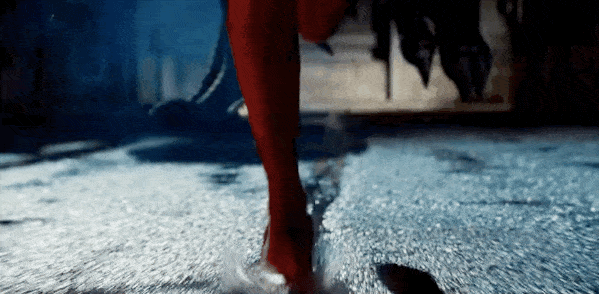
This includes most regular shoes which have a bulky heel and lower toe. In many shoes, you’ll see this difference between heel and forefoot referred to as a “drop,” so “zero-drop” shoes are shoes where heel and forefoot are at the same height.
2. A wide toe box that allows your foot to spread as it lands on the ground with each step. With each step you take, your foot actually spreads wider upon landing. This is impossible for your foot to do when it’s in a shoe that is too narrow.
If the toe box is not at least as wide as your foot when you’re standing on your foot, while it’s bearing your weight, that’s a problem for your foot. Know that as your foot becomes more ‘natural’ it’s possible it will widen further, as the muscles and bones reposition themselves.
Feet crammed into a shoe is like putting a leash on Sonic the Hedgehog: they want to be free!
3. A pliable bottom that allows your toes to bend fully as you step. Your great toe is meant to flex to ninety degrees as you move through the gait cycle. See below:
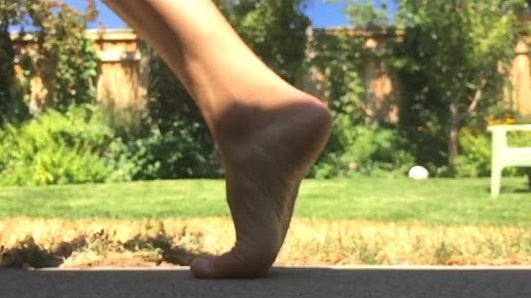
If your shoe does not allow this due to a hard sole, your feet won’t be able to move as well, and the soft tissues of your foot will get weaker from not being used fully. PLUS, when you aren’t flexing your big toe regularly, your body will start to lose the ability to use that joint fully. This can lead to all sorts of problems. Doh!
4. It’s strapped to your foot. If the shoe isn’t strapped around your ankle, your toes are going to grab at the shoe to keep it on with every step you take. This makes some of your foot bones push down and some of your foot bones lift up. That shift means you change the amount of forces on each bone. Over time, this can lead to stress fractures and tissue injuries.
Check out the below video from movement specialist Kelly Starret:
Please don’t run in sandals.
For each point above, this isn’t an “all or nothing” scenario. Similar to your nutrition, do the best you can when you can, and work your way into running with a minimalist shoe.
If you want to learn more on proper footwear, make sure you check out “A Nerd’s Guide to Healthy Feet,” written by Kate Galliett of FitForRealLife.com.
Lastly, if you want to learn more about the benefits of ditching your shoes altogether, you can check out our article “Is Barefoot Running Really Better for You?”
LIFE ON THE RUN

Once you get comfortable running around your neighborhood or park, you can start thinking about taking it to the next level.
Have you ever thought about running a marathon? They can be a lot of fun!
If you want to learn how to get started, make sure you check out our article “Couch to 5K.” We cover the popular program and give our take on running your first race.
Also, if you want even more guidance on running, I’ll point you to my buddy Jason Fitzgerald’s wonderful site Strength Running. I reach out to Jason whenever I need advice on proper running (including the tips found in this post). You can also check out this interview I did with Jason, where we discuss running, proper diet, and Star Wars.
There’s some overlap…

Alright, I think that about does it for this article.
Now, your turn!
Are you an avid runner?
Do you have any tips for Rebels just lacing up?
Or are you like me, and only run when something is chasing you?
Let us know in the comments!
-Steve
PS: I’ll leave you with a final reminder of our 1-on-1 Coaching Program. If you’re blown away by the fact that you don’t have to run to get in shape, but don’t know where else to begin, we got you. We’ll work with you to develop a training program you actually like (could be running, could be strength training, could be yoga), so you can level up your life! Click right here to learn more.
###
All photo sources can be found right here.[7]

No comments:
Post a Comment